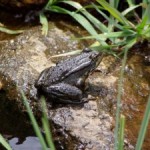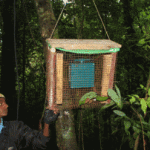We are extremely pleased to feature a guest post by Allystair D. Jones, who studied the canyon tree frog population in Zion National Park, Utah, to determine if the frogs were infected with the chytrid fungus, a disease that is wiping out amphibian populations worldwide. His research will be published by The Utah Academy of Science, Arts and Letters in May 2011.
Chytridiomycosis is an emerging infectious disease that is plaguing the world and causing the extinction of frogs around the globe. This disease is believed to have come from Africa in 1938 when frogs were sometimes used to diagnose pregnancy. This disease is responsible for the extinction of at least 30 populations of frogs and has found its way into Arizona killing the canyon tree frog (Hyla arenicolor). The Chytrid disease can move very quickly and is transferred through water, contact, or even muddy boots from hikers. My research is aimed at watching the population of canyon tree frogs in Zion National Park and as of the summer of 2009 it appeared this population is safe.
The geography of Zion National Park is very unique. Zion is the middle step in the grand staircase with the Grand Canyon being the first and Bryce Canyon the last. This made locating the frogs often very difficult and technical rappelling and climbing skills were needed. I have been climbing for more than 20 years so I was especially suited for this study. I travelled through the canyons where this frog likes to live and captured, swabbed their bellies with a cotton swab, and released them back to the location that I caught them. I used the prescribed swabbing techniques and noted the location and time of the swab. I then saved the samples for DNA testing.
I tested all the samples with a general fungus primer, meaning I tested it to see if there was any fungus at all even if it wasn’t the chytrid fungus. Those that were positive for a fungus were tested for the specific chytrid. The results were very pleasing as none of the samples came up positive for this deadly fungus. This was the first study of this kind done in Zion National Park and during the following year there should be more if the funding keeps up.
It was noted in a review journal article at the beginning of this year (Kilpatrick et al 2010) that to help combat this disease we would need to find a viable population of frogs that are not already infected. I submit this population of frogs to be that population, that if monitored with care may help us gain ground in fighting this deadly disease. We need to increase our efforts to learn about this disease.
For more information or comments my email is: ajones67@dmail.dixie.edu
*KILPATRICK, A. M., BRIGGS, C. J. & DASZAK, P. 2010. The ecology and impact of chytridiomycosis: an emerging disease of amphibians. Trends in Ecology & Evolution, 25, 109-118.











Hey Allystair! It’s great how your research is coming along. I enjoyed meeting you on our trip through Spry Canyon.